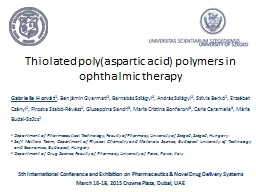PPT-Thiolated
Author : celsa-spraggs | Published Date : 2016-05-20
polyaspartic acid polymers in ophthalmic therapy 5th International Conference and Exhibition on Pharmaceutics amp Novel Drug Delivery Systems March 1618 2015 Crowne
Presentation Embed Code
Download Presentation
Download Presentation The PPT/PDF document "Thiolated" is the property of its rightful owner. Permission is granted to download and print the materials on this website for personal, non-commercial use only, and to display it on your personal computer provided you do not modify the materials and that you retain all copyright notices contained in the materials. By downloading content from our website, you accept the terms of this agreement.
Thiolated: Transcript
polyaspartic acid polymers in ophthalmic therapy 5th International Conference and Exhibition on Pharmaceutics amp Novel Drug Delivery Systems March 1618 2015 Crowne Plaza Dubai UAE Gabriella Horvát.
Download Document
Here is the link to download the presentation.
"Thiolated"The content belongs to its owner. You may download and print it for personal use, without modification, and keep all copyright notices. By downloading, you agree to these terms.
Related Documents

